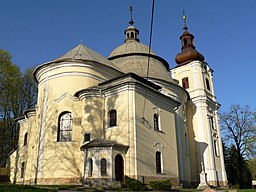Šenov
| Šenov | |||
| Town | |||
|
Divine Providence Church
|
|||
|
|||
| Country | Czech Republic | ||
|---|---|---|---|
| Region | Moravian-Silesian | ||
| District | Ostrava-City | ||
| Elevation | 255 m (837 ft) | ||
| Coordinates | 49°47′3″N 18°22′47″E / 49.78417°N 18.37972°ECoordinates: 49°47′3″N 18°22′47″E / 49.78417°N 18.37972°E | ||
| Area | 16.63 km2 (6.42 sq mi) | ||
| Population | 6,029 (1.1.2012) | ||
| Density | 363/km2 (940/sq mi) | ||
| First mentioned | 1305 | ||
| Mayor | Ing. Jan Blažek | ||
| Timezone | CET (UTC+1) | ||
| - summer (DST) | CEST (UTC+2) | ||
| Postal code | 739 34 - 739 34 | ||
| Statistics: statnisprava.cz | |||
| Website: www.mesto-senov.cz | |||
Šenov (Czech pronunciation: [ˈʃɛnof]; Polish: Szonów; German: Schönhof) is a town in the Ostrava-City District, Moravian-Silesian Region, Czech Republic. It has a population of 5,919(2010). It lies in the historical region of Těšín Silesia.
The settlement was first mentioned in a Latin document of Diocese of Wrocław called Liber fundationis episcopatus Vratislaviensis from around 1305 as item in Sonow. It meant that the village was in the process of location (the size of land to pay tithe from was not yet precised). The creation of the village was a part of a larger settlement campaign taking place in the late 13th century on the territory of what will be later known as Upper Silesia.
Politically the village belonged initially to the Duchy of Teschen, formed in 1290 in the process of feudal fragmentation of Poland and was ruled by a local branch of Piast dynasty. In 1327 the duchy became a fee of Kingdom of Bohemia, which after 1526 became part of the Habsburg Monarchy.
The village could have become a seat of a Catholic parish if Schonwald mentioned in a register of Peter's Pence payment from 1447 among 50 parishes of Teschen deaconry was a temporary but similar name for the village at that time. After 1540s Protestant Reformation prevailed in the Duchy of Teschen and a local Catholic church was taken over by Lutherans. It was taken from them (as one from around fifty buildings in the region) by a special commission and given back to the Roman Catholic Church on 25 March 1654.
...
Wikipedia







